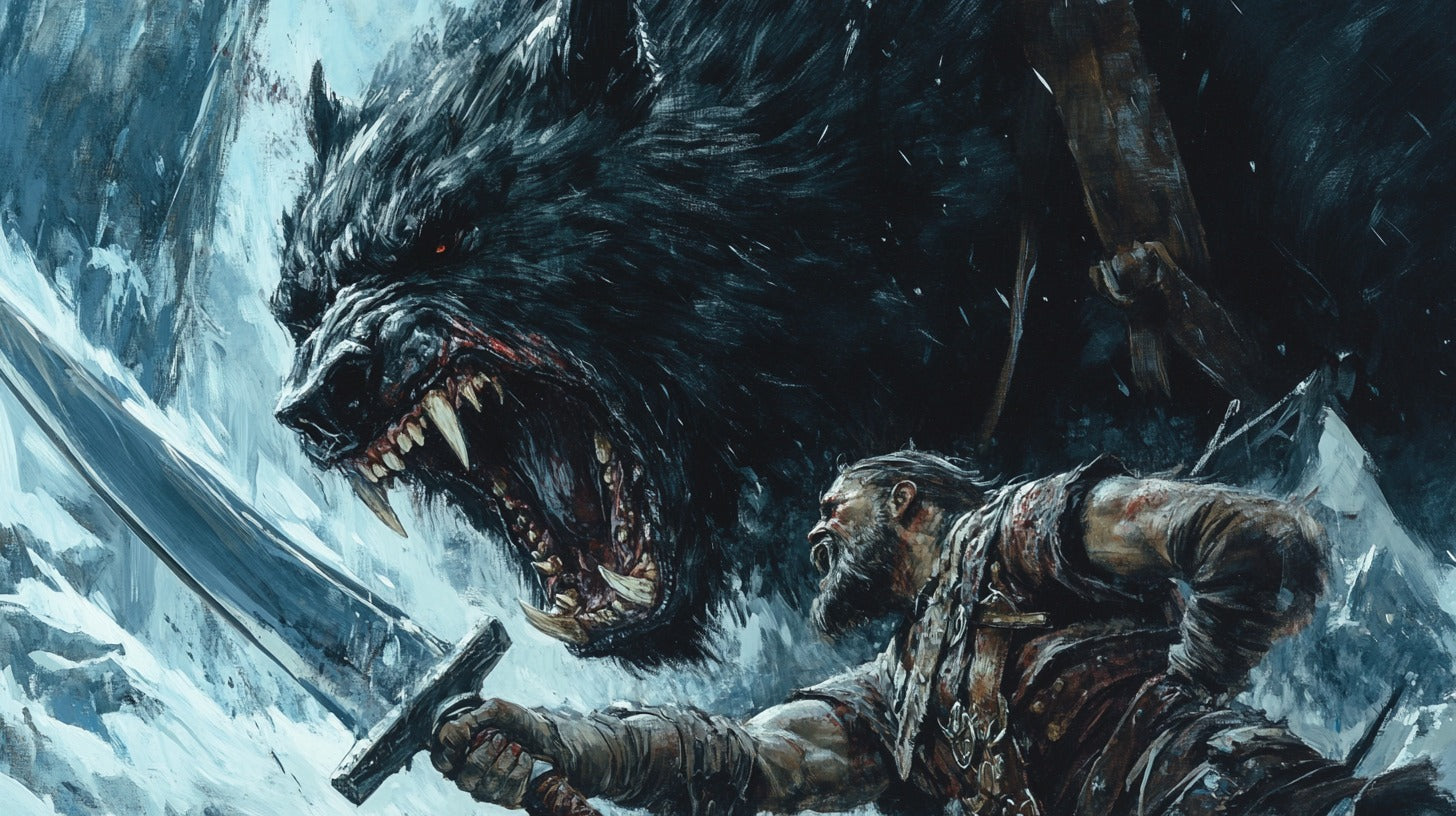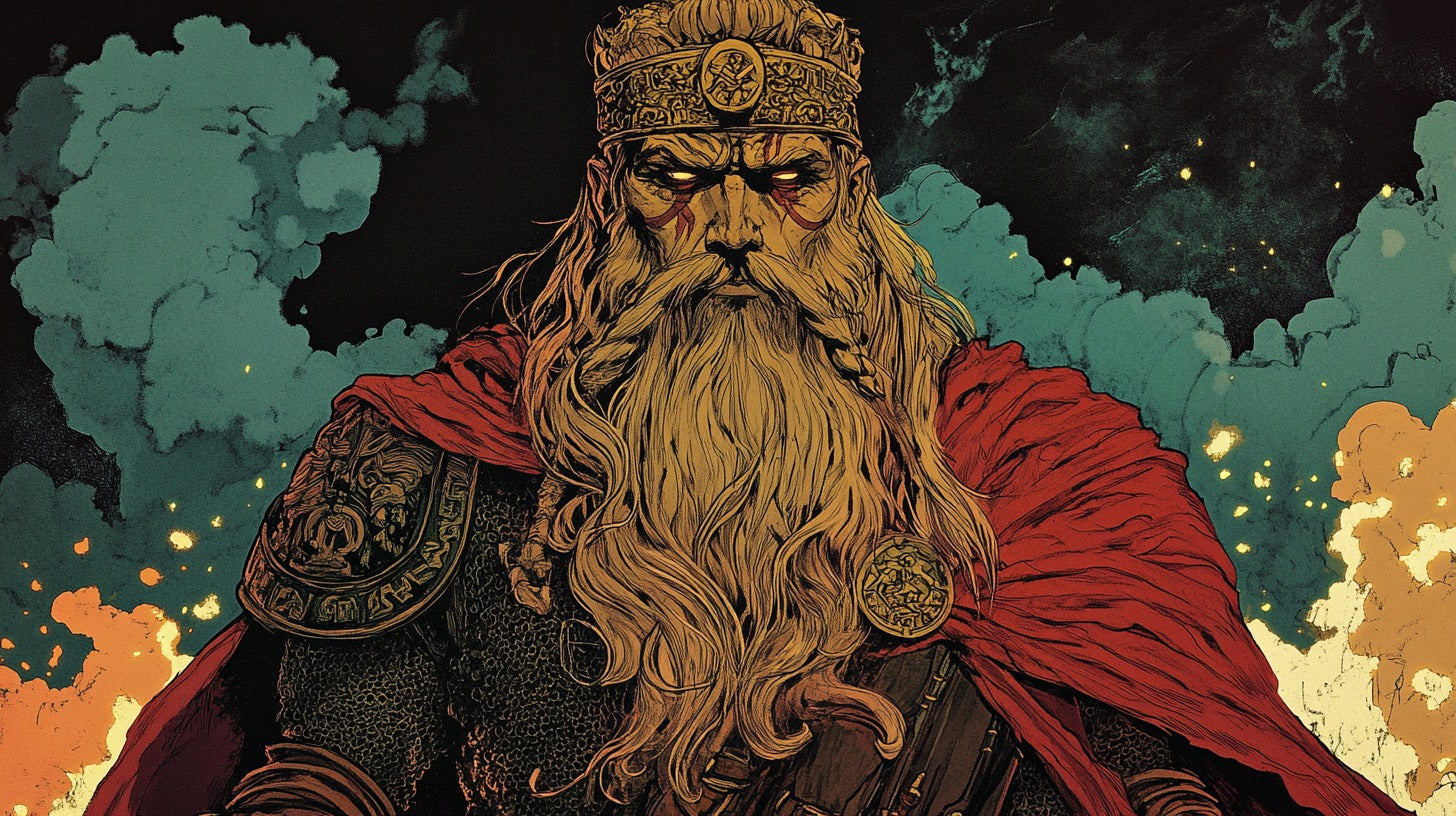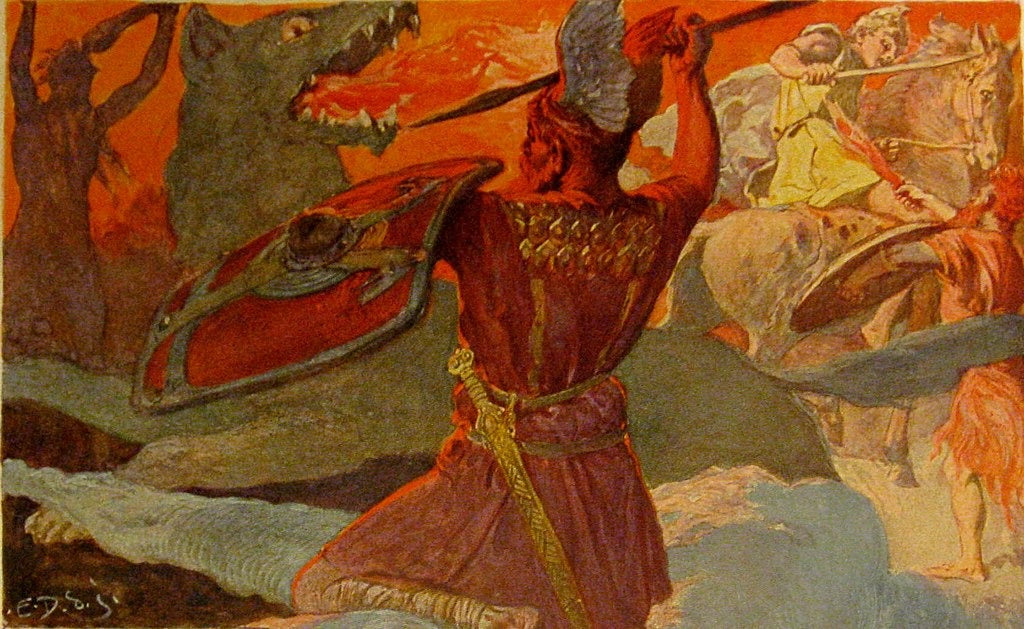
Víðarr: The Silent God of Vengeance
Víðarr, one of the most enigmatic figures in Norse mythology, appears in several key medieval texts that form our primary understanding of Norse religious traditions. The most detailed accounts of Víðarr come from Snorri Sturluson's Prose Edda (13th century) and the older Poetic Edda. The god is particularly prominent in the Vafþrúðnismál and Grímnismál poems, which provide crucial information about his role in Norse cosmology.
Archaeological Evidence
Archaeological evidence specifically relating to Víðarr is limited, though several medieval stone carvings and runestones contain imagery that scholars interpret as potentially representing the god. Notable examples include decorative elements found in Norway and Iceland dating from the 9th to 11th centuries CE, though definitive identification remains challenging due to the abstract nature of many Norse artistic representations.
Divine Lineage and Family

A 1908 depiction by W. G. Collingwood of Víðarr slaying Fenrir, inspired by the imagery on the Gosforth Cross. The illustration shows Víðarr holding the wolf's jaws apart while delivering the fatal blow.
Relationship to Odin
Víðarr holds a distinct position in the Norse pantheon as one of Odin's sons, born to the giantess Gríðr. This mixed parentage places him among the group of gods with both Æsir and Jötunn heritage, reflecting the complex interrelationships between these two mythological races. His status as Odin's son carries particular significance given his destined role in Ragnarök.
Connection to Grid
Gríðr (Grid), Víðarr's mother, is described in the sources as a wise giantess who aids Thor on his journeys. Her relationship with Odin, though not extensively detailed in surviving texts, results in the birth of Víðarr, whose unique attributes and destiny suggest a careful fusion of divine and giant characteristics.
Mythological Role

Vidarr & Fenrisúlfr Clash - Old Norse Mythology Inspired Amulet
The Silent One
Víðarr is frequently referred to as "the Silent God" or "the Silent One" in Norse mythology. This epithet likely relates to his reserved nature and possible connection to sacred oaths or vows of silence, though the exact significance of this title remains a subject of scholarly debate. Despite his quiet nature, Víðarr's importance in Norse mythology is substantial, particularly concerning the events of Ragnarök.
Ragnarök Prophecies
The most significant aspect of Víðarr's mythology concerns his role in Ragnarök, the prophesied destruction and rebirth of the world. According to both Eddas, Víðarr is destined to avenge his father Odin's death by slaying the great wolf Fenrir. This act makes him one of the few gods prophesied to survive Ragnarök and participate in the creation of the new world that follows.
Attributes and Symbolism

Detail of the Gosforth Cross, artist unknown, 1913. This section depicts the Norse mythological scene of Víðarr fighting the wolf Fenrir during Ragnarök, showing Víðarr prying Fenrir's jaws apart. The cross blends Viking imagery with Christian symbolism, illustrating stories from Norse mythology.
The Thick Shoe
One of Víðarr's most distinctive attributes is his special shoe, described in various sources as being particularly thick or strong. According to tradition, this shoe is made from the leather scraps that people throw away when making or repairing footwear. This detail created a cultural practice where Norse people would traditionally save leather scraps to contribute to Víðarr's shoe, believing this would help him in his eventual battle with Fenrir.
Iron Forest Dwelling
Víðarr is associated with a realm called Vidi (Víði), described as a land of long grass and young trees. This connection to an iron wood or forest suggests possible associations with both wilderness and craftsmanship, though interpretations of this symbolism vary among scholars.
Cultural Impact

Handcrafted Byzantine Chain Wolf Mjölnir Amulet
Religious Significance
In pre-Christian Scandinavian society, Víðarr's worship appears to have been closely connected to concepts of vengeance, justice, and survival. Archaeological evidence suggests that his cult may have been particularly important in regions where family honor and blood feuds played significant social roles, though direct evidence of dedicated worship sites remains scarce.
Modern Interpretations
Contemporary interest in Víðarr has grown alongside the broader revival of interest in Norse mythology. His role as an avenger and survivor has resonated with modern audiences, particularly in literary and artistic representations. His character has been interpreted variously as a symbol of justice, perseverance, and the triumph of silence over chaos.
Conclusion
The study of Víðarr remains an important component in understanding Norse mythology and its influence on medieval Scandinavian society. While historical sources may be limited, the consistency of his portrayal across various texts suggests his significant role in Norse religious thought. His character embodies themes of vengeance, justice, and survival that resonated deeply with medieval Scandinavian culture and continue to intrigue scholars and enthusiasts today. The combination of his silent nature, prophesied heroic role, and survival of Ragnarök makes him a uniquely compelling figure in Norse mythology, worthy of continued study and analysis.
Frequently Asked Questions (FAQs)
- Why is Víðarr called the Silent God?
While the exact reason isn't explicitly stated in surviving sources, his epithet "the Silent One" may relate to sacred vows or his reserved nature among the gods.
- How does Víðarr kill Fenrir?
According to the prophecies, he uses his specially reinforced shoe to hold open Fenrir's lower jaw while grasping the upper jaw, eventually tearing the wolf apart.
- What is the significance of Víðarr's shoe?
The shoe, made from collected leather scraps, represents both divine craftsmanship and human participation in preparing for Ragnarök.
- Is Víðarr one of the survivors of Ragnarök?
Yes, sources consistently list him among the few gods who survive Ragnarök and help establish the new world order.
- What evidence exists for the worship of Víðarr in historical Scandinavia?
While direct archaeological evidence is limited, literary sources and some archaeological findings suggest he was venerated, particularly in contexts relating to vengeance and justice.
References
Sturluson, Snorri. "Edda." Translated by Anthony Faulkes. Everyman's Library, 1995.
Larrington, Carolyne. "The Poetic Edda." Oxford World's Classics, 2014.
Lindow, John. "Norse Mythology: A Guide to Gods, Heroes, Rituals, and Beliefs." Oxford University Press, 2001.
Price, Neil. "The Viking Way: Religion and War in Late Iron Age Scandinavia." Oxford University Press, 2002.
Simek, Rudolf. "Dictionary of Northern Mythology." D.S. Brewer, 1993.
Davidson, H.R. Ellis. "Gods and Myths of Northern Europe." Penguin Books, 1990.
Orchard, Andy. "Dictionary of Norse Myth and Legend." Cassell, 1997.
Pluskowski, Aleksander. "Archaeology of the Viking Age." Cambridge University Press, 2017.
Andrén, Anders. "Old Norse Religion in Long-term Perspectives." Nordic Academic Press, 2006.
DuBois, Thomas A. "Nordic Religions in the Viking Age." University of Pennsylvania Press, 1999.








